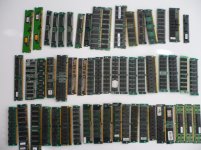microfloppydik
New Member
- Joined
- Oct 27, 2015
- Messages
- 2
Ok,
First post here, so please be gentle.
Also, I'm not sure if I posted this in the wrong forum or not - moderator, please help.
I'm trying to figure out what kind of RAM or modules are in these photos because I have no idea.
Can you help?
There are three rows. I also took pictures of the backsides in the second photo.
Thank you very much in advance.
First post here, so please be gentle.
Also, I'm not sure if I posted this in the wrong forum or not - moderator, please help.
I'm trying to figure out what kind of RAM or modules are in these photos because I have no idea.
Can you help?
There are three rows. I also took pictures of the backsides in the second photo.
Thank you very much in advance.


